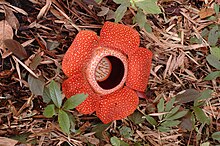大花草属
| 大花草属 | |
|---|---|

| |
| 科学分类 | |
| 界: | 植物界 Plantae |
| 演化支: | 维管植物 Tracheophyta |
| 演化支: | 被子植物 Angiosperms |
| 演化支: | 真双子叶植物 Eudicots |
| 演化支: | 蔷薇类植物 Rosids |
| 目: | 金虎尾目 Malpighiales |
| 科: | 大花草科 Rafflesiaceae |
| 属: | 大花草属 Rafflesia R.Br., 1821 |
| 模式种 | |
| 阿诺尔特大花草 Rafflesia arnoldii R.Br., 1821
| |
| 物种 | |
|
见正文 | |
大花草属(学名:Rafflesia)又名大王花属、莱佛士花属、尸花属,是世界上最大的一种花。原生于马来半岛及婆罗洲、苏门答腊等岛屿。大花草无根无茎,是一种寄生植物,靠吸收葡萄科的崖爬藤属养分为生。其直径可达1.4米。大花草开花时会释出腐肉般的臭气,靠吸引苍蝇与甲虫为其传粉。
其中最大的一种大花草为阿诺尔特大花草,其花直径能够达到3尺之长。
描述
[编辑]
下属物种
[编辑]本属包括以下物种:
- 阿诺尔特大花草 Rafflesia arnoldii R.Br.,大王花[1]
- 近打大花草 Rafflesia aurantia Barcelona, Co & Balete,橙黄大花草[1]
- 阿兹兰大花草 Rafflesia azlanii Latiff & M.Wong[1]
- 伊萨洛克大花草 Rafflesia baletei Barcelona & Cajano[1]
- Rafflesia banaoana Malabrigo[2][1]
- Rafflesia banahawensis [1]
- 明古鲁大花草 Rafflesia bengkuluensis Susatya, Arianto & Mat-Salleh[1]
- 婆罗洲大花草 Rafflesia borneensis Koord.,婆罗大花草
- Rafflesia camarinensis F.B.Valenz., Jaucian-Adan, Agoo & Madulid
- 茎生大花草 Rafflesia cantleyi Solms[1]
- 缘毛大花草 Rafflesia ciliata Koord.
- 康氏大花草 Rafflesia consueloae Galindon, Ong & Fernando[3][1]
- 芽笃大花草 Rafflesia gadutensis Meijer[1]
- Rafflesia hasseltii Suringar[1]
- 爪哇大花草 Rafflesia horsfieldii R. Br.
- 沙巴大花草 Rafflesia keithii Meijer[1]
- Rafflesia kemumu Susatya, Hidayati & Riki[4]
- 凯里大花草 Rafflesia kerrii Meijer,泰国大花草
- Rafflesia lagascae Blanco
- Rafflesia lawangensis Mat-Salleh, Mahyuni & Susatya
- Rafflesia leonardi Barcelona & Pelser[1]
- 浅裂大花草 Rafflesia lobata R.Galang & Madulid[1]
- 马尼拉大花草 Rafflesia manillana Teschem.[1]
- Rafflesia meijeri Wiriad. & Sari
- 鹿蹄大花草 Rafflesia micropylora Meijer
- 惊奇大花草 Rafflesia mira Fernando & Ong[1]
- 混杂大花草 Rafflesia mixta Barcelona, Manting, Arbolonio, R.B.Caball. & Pelser[1]
- Rafflesia micropylora Meijer, 1981[1]
- 小斑大花草 Rafflesia parvimaculata Sofiyanti, Mat-Salleh, Khairil, Zuhailah, Mohd.Ros & Burslem[5]
- Rafflesia panchoana [1]
- 钵头摩大花草 Rafflesia patma Blume[1]
- 菲律宾大花草 Rafflesia philippensis Blanco
- Rafflesia pricei Meijer
- 银山大花草 Rafflesia rochussenii Teijsm. & Binn.[1]
- Rafflesia schadenbergiana Göpp. ex Hieron.[1]
- Rafflesia sharifah-hapsahiae J.H.Adam, Rahmah, Aizat-Juhari & K.L.Wan
- 美丽大花草 Rafflesia speciosa Barcelona & Fernando
- Rafflesia su-meiae M.Wong, Nais & F.Gan
- 东姑阿德林大花草 Rafflesia tengku-adlinii K.Mat-Salleh & Latiff
- Rafflesia tiomanensis Siti-Munirah, Salamah & Razelan
- 王子大花草 Rafflesia tuan-mudae Becc.[1]
- Rafflesia tuanku-halimii J.H.Adam, Aizat-Juhari, Azilah & K.L.Wan
- 多疣大花草 Rafflesia verrucosa Balete, Pelser, Nickrent & Barcelona[1]
发现
[编辑]最初由法国人 Louis Deschamps 于1791-1794年在爪哇发现,但他的笔记被英国人于1803年没收。 直到1818年,自然学家约瑟夫·阿诺德(Joseph Arnold)和英国在新加坡殖民地的创建者托马斯·斯坦福德·莱佛士(Sir Thomas Stamford Bingley Raffles)率领的科学探险队在印尼苏门答腊发现了这种植物,并以莱佛士的名字命名。其带有斑点的血红色花朵有7千克重,直径一般1米以上,散发一种腐烂尸体般的恶臭;同时生产热量[6],吸引苍蝇和几种食腐蜂类来传播花粉。
进化和系统发育
[编辑]


| 大戟科 sensu lato |
| ||||||||||||||||||||||||
2010 年对18种大花草属的分子亲缘关系学发育研究发现,它们分为四个明确的地理定义组:[7]
| 大花草属 Rafflesia |
| ||||||||||||||||||||||||||||||||||||||||||||||||||||||||||||||||||||||||||||||||||||||||||||||||||||||
However, the clear monophyly of the four geographical clades does not correspond to any clear difference in appearance. There is no consistency within the clades in the size of flowers, or the presence or absence of white warts; species in different clades resemble one another more than they do some other species within the same clade. Homoplasy – repeatedly gaining or losing traits – seems to be the rule within Rafflesia.[7]
接受的物种
[编辑]其他名称
[编辑]叶绿体基因组的丢失
[编辑]分配
[编辑]生态
[编辑]作为植物,大花草并不能进行光合作用,而是靠着寄生在葡萄科崖爬藤属一类的热带藤类上吸收养分存活。大花草没有根、茎、叶等一般植物的部分,只有几片花瓣;从长出花苞到开花需9个月的时间,花期为3天到1周左右。
刚开花时大花草会发出一种淡淡的香味,而随后会变成一种腐肉般的恶臭,并借由这种味道吸引苍蝇等食腐昆虫替自己传播花粉。
大王花开花期过后,会崩塌成一团类似烧焦的黑色黏稠物质。
成功授粉后的花在6-12个月后会长出果实,果实中有数千颗小种子由松鼠或树鼩传播。种子可能是传播者透过排泄物或是他们在啃咬藤蔓时传播,另一种说法认为大王花的种子带有油体,许多有此类油体的草本植物皆透过蚂蚁传播,蚂蚁在吸取被动物咬伤的藤蔓流出的汁液时,顺道散播了种子。[1](页面存档备份,存于互联网档案馆)
起源
[编辑]生物学家戴维斯说,大花草属植物的起源要追溯到约1亿年前的白垩纪,即恐龙时代末期。一般认为,开花植物从那时候才开始在地球上出现。研究人员推断,大花草的花朵在4600万年间增大了约79倍,然后才进入缓慢的进化阶段。
参见
[编辑]外部链接
[编辑]
- ^ 1.00 1.01 1.02 1.03 1.04 1.05 1.06 1.07 1.08 1.09 1.10 1.11 1.12 1.13 1.14 1.15 1.16 1.17 1.18 1.19 1.20 1.21 1.22 1.23 Pastor Malabrigo Jr., Adriane B. Tobias, Joko Witono, Sofi Mursidawati, Agus Susatya, Mat Yunoh Siti-Munirah, Adhityo Wicaksono, Reza Raihandhany, Sarah Edwards and Chris J. Thorogood. 2023. Most of the World's Largest Flowers (Genus Rafflesia) are now on the Brink of Extinction. PLANTS, PEOPLE, PLANET. DOI: 10.1002/ppp3.10431
- ^ Adriane B. Tobias, Chris J. Thorogood and Pastor L. Malabrigo Jr. 2023. The Reinstatement of Rafflesia banaoana (Rafflesiaceae), and Implications for Assessing Species Diversity and Conservation Requirements of the World's Largest Flowers. Phytotaxa. 612(2); 201-216. DOI: 10.11646/phytotaxa.612.2.5
- ^ John Michael M. Galindon, Perry S. Ong and Edwino S. Fernando. 2016. Rafflesia consueloae (Rafflesiaceae), The Smallest among Giants; A New Species from Luzon Island, Philippines. PhytoKeys. 61: 37-46. DOI: 10.3897/phytokeys.61.7295
- ^ Agus Susatyaม Siti Nur Hidayati and Septian Riki. 2017. Rafflesia kemumu (Rafflesiaceae), A New Species from Northern Bengkulu, Sumatra, Indonesia. Phytotaxa. 326(3); 211–220. DOI: 10.11646/phytotaxa.326.3.5
- ^ Nery Sofiyanti, Kamarudin Mat-Salleh, Khairil Mahmud, Nor Zuhailah Mazlan, Mohd. Ros. Albukharey Hasein and David F.R.P. Burslem. 2016. Rafflesia parvimaculata (Rafflesiaceae), A New Species of Rafflesia from Peninsular Malaysia. Phytotaxa. 253(3); DOI: 10.11646/phytotaxa.253.3.4
- ^ Patiño, Sandra; Aalto, Tuula; Edwards, Alice A.; Grace, John. Is Rafflesia an endothermic flower?. New Phytologist. 2002-05, 154 (2) [2024-05-28]. ISSN 0028-646X. doi:10.1046/j.1469-8137.2002.00396.x. (原始内容存档于2024-05-28) (英语).
- ^ 7.0 7.1 Bendiksby, Mika; Schumacher, Trond; Gussarova, Galina; Nais, Jamili; Mat-Salleh, Kamarudin; Sofiyanti, Nery; Madulid, Domingo; Smith, Stephen A. & Barkman, Todd. Elucidating the evolutionary history of the Southeast Asian, holoparasitic, giant-flowered Rafflesiaceae: Pliocene vicariance, morphological convergence and character displacement. Molecular Phylogenetics and Evolution. 2010-11-01, 57 (2): 620–633. PMID 20723606. doi:10.1016/j.ympev.2010.08.005.


